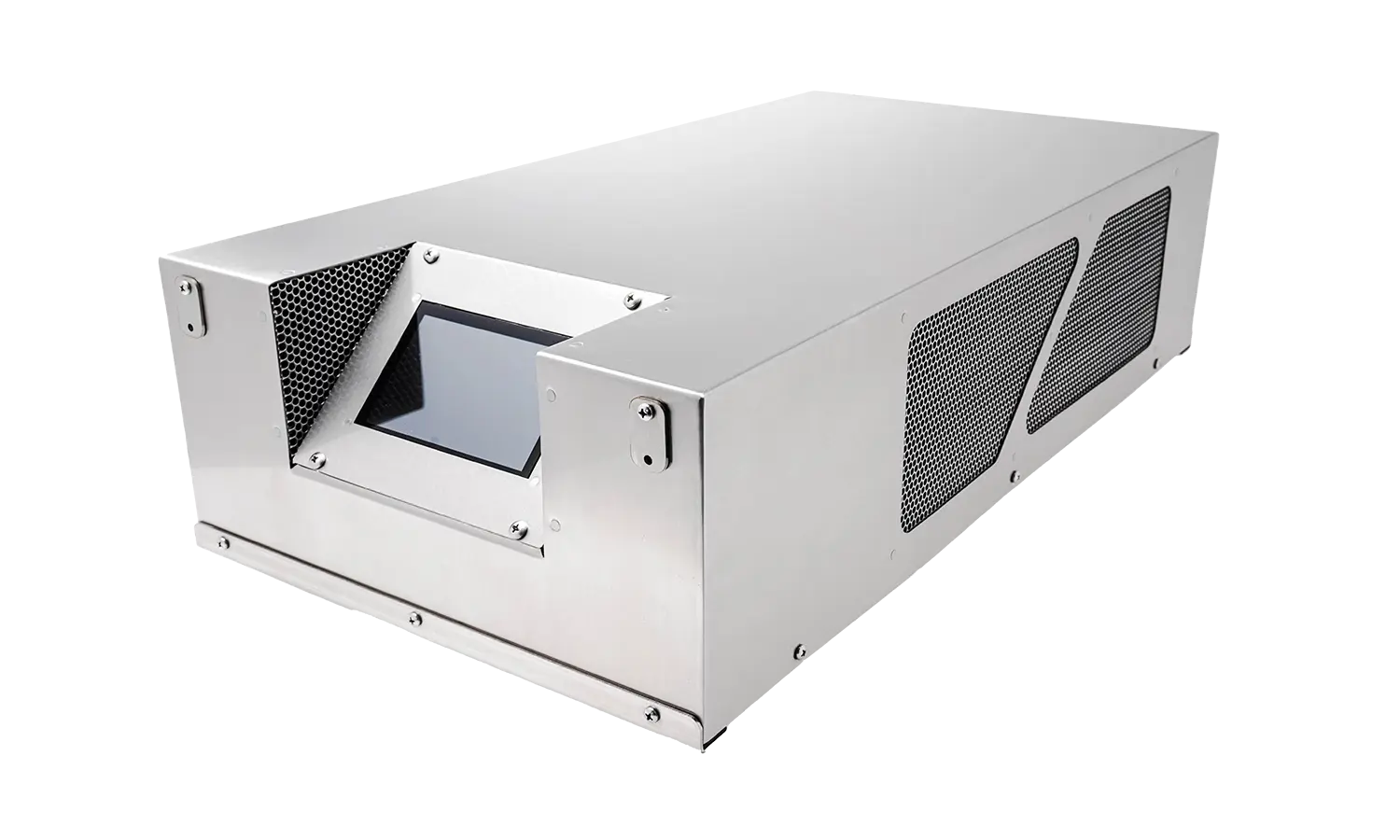Ozone Library
Ozone Therapy in Dentistry
INTRODUCTION
Atmospheric air is made up of nitrogen (71%), oxygen (28%), and other gasses (1%) including ozone which is altered by processes related to altitude, temperature, and air pollution.1,2 Ozone (O3) is a gas with a characteristic, penetrating odor that is present in small amounts in atmospheric air. Ozone molecules are composed of three oxygen atoms and present naturally in the upper layer of the atmosphere in abundance as long as the sun is shining. 1,3, 4 It protects living organisms by surrounding the earth at altitudes of 50,000 to 100,000 feet from the ultra-violet rays.1,2,6 As it falls down to earth, being heavier than air, and combines with any pollutant it comes in contact with and cleans the air. This is Mother Earth’s natural way of self-cleaning.3
Medical Ozone is made when medical grade oxygen is electrically activated (using an Ozone Generator) to form ozone.3 It is a mixture of the purest oxygen and purest ozone. According to its application, the ozone concentration may vary between 1 and 100 µg/ml (0.05-5%). The ozone therapist determines the complete dosage according to the medical/dental indication and the patient’s condition.7, 8
Ozone is an unstable gas and it quickly gives up nascent oxygen molecules to form oxygen gas. The release of nascent oxygen has beneficial effects on every part and organ. It has been used in the medical field for a long back due to its extremely strong oxidant property that oxidizes nearly all surfaces to the highest oxidation stage. It is used as a circulatory enhancement and stimulation of oxygen metabolism, disruption of tumor metabolism, and kills pathogens. O3 is a powerful oxidant capable of interacting as a metabolic & immune modulator as well as an anti-microbial agent. Multiple microbiological & biochemical studies justified that there are no doubts about the effectiveness of ozone in bacterial reduction. Among other things, ozone is used to purify drinking water and water in dental equipment and for sterilizing instruments for medical use.10
HISTORY
The German chemist Christian Friedrich Schönbein (1840), of the University of Basel in Switzerland, is regarded as the Father of ozone therapy.7,11 When he passed an electrical discharge through water, a gas strange smell was produced, which he called Ozone, derived from the Greek word ozein which means odor.1,2,6,11 In 1857Joachim Hänsler, a German physicist and physician, along with German physician, Hans Wolff, developed the first ozone generator for medical use. Dr. C. Lender in 1870, for the first time, applied O3 into the medical field.
He purified blood in test tubes by using O3.2,3,6 Later, the O3 application gained popularity as a therapeutic procedure throughout Europe and America. In 1881, it was used as a disinfectant in the treatment of diphtheria.3 Dr. Charles Kenworthy, a Florida physician, in 1885, published his experiences with ozone in the Florida Medical Association Journal.5 In October 1893, Ousbaden, Holland became the first city to utilize a water treatment plant using ozone.3 In World War I and II it was used to treat wounded soldiers in the trenches.11, 12 In the early 20th-century food and Drug Act, revised its use and effect in the field of medicine.
They considered it perfectly legal to use in the US. Since then, it was used in the treatment of then deadly diseases such as tuberculosis, pneumonia, diabetes, etc. It was also used to cure wounds, gangrene, and the effects of poisonous gas. As of 1929, more than 114 diseases were listed for treatment with oxygen/ ozone therapy.5A German dentist, Dr. E.A.Fisch, in 1950 the first dentist become to use ozone on regular basis in his dental practice in Zurich, Switzerland, and published numerous papers on its application. He used ozone to treat Ernst Payr, a renowned Austrian surgeon, who then became an ozone enthusiast and began a line of research dedicated to its use in healthcare.
At that time, ozone therapy was difficult and limited due to the lack of ozone-resistant materials, such as Nylon, Dacron, and Teflon, until when ozone-resistant materials were manufactured.1,2, 5, 6Beginning of dental-application research with the approval of an Institutional Review Board for Human Research from the Capital University of Integrative Medicine in Washington, D.C., started in 2001.
The first formal lecture on oxygen/ozone therapy was given in 2001 at Capital University. Later on, extensive research continued with the publication of Dr. Siegfried Rilling’s and Dr. Renate Viebahn’s text, “The Use of Ozone in Medicine.” This text was a standard until 2002 when Dr. Velio Bocci published “Oxygen/Ozone Therapy – A Critical Review.” This was followed by the first dental-applications clinical seminar in Louisville, Ky., in 2003. In 2004, Professor Edward Lynch of Belfast, United Kingdom, contributed to and edited the book “Ozone: The Revolution in Dentistry.”5 Numerous researchers since that time have worked to elucidate the nature and actions of ozone. Mariniak and Delarive showed that it is an allotropic form of oxygen, and Mulliken and Dewar clarified its molecular structure.6, 13
BIOLOGICAL ACTIONS
There are several known actions of ozone on the human body, such as immunostimulating and analgesic, antihypoxic and detoxicating, antimicrobial, bioenergetic, and biosynthetic (activation of the metabolism of carbohydrates, proteins, lipids), etc.
The antimicrobial effect of ozone as a result of its action on cells by damaging its cytoplasmic membrane due to ozonolysis of dual bonds and also ozone-induced modification of intracellular contents (oxidation of proteins loss of organelle function) because of secondary oxidants effects. This action is non-specific and selective to microbial cells; it does not damage human body cells because of their major antioxidative ability. Ozone is very efficient in antibiotics-resistant strains. Its antimicrobial activity increases in the liquid environment with the acidic pH. In viral infections, the ozone action lies in the intolerance of infected cells to peroxides and the change of activity of reverse transcriptase, which takes part in the synthesis of viral proteins.
Ozone influences the cellular and humoral immune systems. It stimulates the proliferation of immunocompetent cells and the synthesis of immunoglobulins. It also activates the function of macrophages and increases the sensitivity of micro-organisms to phagocytosis.6 When administered at low concentrations, the organism’s own resistance is mobilized, i.e. ozone (re)activates the immune system. 8 As a response to this activation through ozone, the body’s immune cells produce special messengers called cytokines. These molecules in turn activate other immune cells, setting off a cascade of positive change throughout the immune system, which is stimulated to resist diseases. This means that the application of medical ozone is extremely useful for immune activation in patients with low immune status and/or immune deficit.7 Ozone causes the synthesis of biologically active substances such as interleukins, leukotrienes, and prostaglandins which are beneficial in reducing inflammation and wound healing.
Ozone brings about the rise of pO2 in tissues and improves the transportation of oxygen in the blood, which results in a change in cellular metabolism – activation of aerobic processes (glycolysis, Krebs cycle, ?-oxidation of fatty acids) and use of energetic resources. It also prevents the formation of erythrocytes aggregates and increases their contact surface for oxygen transportation. Its ability to stimulate circulation is used in the treatment of circulatory disorders and makes it valuable in revitalizing organic functions.
Ozone causes secretion of vasodilators such as NO, which is responsible for dilatation of arterioles and venules.
It activates mechanisms of protein synthesis and increases the number of ribosomes and mitochondria in cells. These changes on the cellular level explain the elevation of functional activity and regeneration potential of tissues and organs.
A high concentration of ozone kills bacteria very quickly and is a thousand times more powerful than other bacterial killing agents. The average concentration of ozone used in treatments is 25 µgm of ozone per milliliter of oxygen/ozone gas mixture which translates into 0.25 parts of ozone to 99.75 parts of oxygen.
Evidence-based research has shown that at this concentration, ozone effectively kills bacteria, fungi, viruses, and parasites. As an antimicrobial agent, it is a powerful oxidizer at a dramatically lower concentration than chlorine with none of the toxic side effects. One molecule of ozone is equal to between 3,000 to 10,000 molecules of chlorine and it kills pathogenic organisms 3,500 times faster.5Studies have revealed that it only takes 10 sec to kill 99 % of bacteria, fungi, and viruses.14 It can oxidize many organic compounds and it is a powerful germicide.15 Some of the other effects are a circulatory enhancement, disruption of tumor metabolism, and stimulation of oxygen metabolism.
GOALS OF OZONE THERAPY IN DENTISTRY
Setting the standard of care and therapeutic goals based on sound evidence-based science is critical. Therapeutic goals are inclusive and not exclusive to the standard of care. The goals of oxygen/ozone therapy are:
Elimination of pathogens.
Restoration of proper oxygen metabolism.
Induction of a friendly ecologic environment.
Increased circulation.
Immune activation.
Simulation of the humoral anti-oxidant system.
SYSTEMS FOR GENERATING OZONE GAS IN DENTISTRY:
Ultraviolet system: Produces low concentrations of ozone, used in aesthetics and for air purification.
Cold plasma system: used in air and water purification.
Corona discharge system: produces high concentrations of ozone. It is the most common system used in the medical/ dental field. It is easy to handle and it has a controlled ozone production rate.
OZONE THERAPY IN DENTISTRY FORMS OF APPLICATION
As an infusion into the infected jaw bone (cavitation) or into the temporomandibular joint for the treatment of pain and inflammation.
As an irrigant during new root canal therapy to disinfect the involved tooth.
Adjunctive therapy with the use of Ozonated Olive Oil for periodontal disease.
INDICATIONS
In dentistry, ozone has got a role in various dental treatment modalities. Ozone therapy presents great advantages when used as a support for conventional treatments.
Prophylaxis and prevention of dental caries.
Remineralization of pit and fissure, root, and smooth surface caries.
Restoration of open cavitations along with conventional conservative measures.
Bleaching of discolored root canal-treated teeth.
Endodontic treatment.
Desensitization of extremely sensitive tooth necks.
Soft tissue pathoses.
The treatment of infected, badly healing wounds and inflammatory process.
OZONE THERAPY IN PROSTHODONTICS
Microbial plaque accumulating on the dentures is composed of several oral microorganisms, mainly C. albicans. Denture plaque control is essential for the prevention of denture stomatitis. In an attempt to solve this problem Arita et al. assessed the effect of ozonated water in combination with ultrasonication on C. albicans. Following exposure to flowing ozonated water (2 or 4 mg/l) for one minute, they found no viable C. albicanssuggesting the application of ozonated water might be useful in reducing the number of C.albicanson denture bases.17
OZONE THERAPY IN SURGERY
The influence of ozonized water on the epithelial wound healing process in the oral cavity was observed by Filippi. It was found that ozonized water applied on the daily basis can accelerate the healing rate in the oral mucosa. This effect can be seen in the first two postoperative days. The comparison with wounds without treatment shows that daily treatment with ozonized water accelerates the physiological healing rate.18 Patients treated with ozone got healed more quickly without the need for systemic medication when compared to the control group. This finding suggested that ozonated oil might be effective in the treatment of alveolitis.19 Application of ozone therapy after tooth extraction and in case of post-extraction complications, was found quite useful.20
OZONE THERAPY IN ENDODONTICS
Current research has been focused on determining guidelines for ozone use. The principle line of study has evolved using the ozone to determine its effect on several kinds of caries (pit and fissure,21 noncavity22, and primary root caries21,23,24,25).
The oxidative impact on this microbiota has been recognized in several studies; however, there is a divergence of opinion regarding the amount of time that ozone gas should be applied. One study suggests application of ozone gas for a period of 10 to 20 seconds resulted in 99% of the microorganisms being destroyed 24,25. Another report states that 40 seconds of application was insufficient to decontaminate the area and failed to act on underlying infected dentin26. Interesting data shows ozone does not affect the sealing ability of the bonding system. Ozone therapy was also used in the prevention of dental caries in fissures of the first permanent molars in children.20 An interesting data shows ozone does not affect the sealing ability of the bonding system 27.
Polymicrobial infections complicate cases of apical periodontitis. As a result, current research is focused on finding treatment solutions with a high antimicrobial effect while minimizing injury to the periapical tissues. The oxidative power of ozone characterizes it as an efficient antimicrobial and its indication for use in endodontic therapy seems quite appropriate. Its antimicrobial action has been demonstrated against bacterial strains such as Mycobacteria, Staphylococcus, Streptococcus, Pseudomonas, Enterococcus, and E. Coli 31,32 S. aureus33, E. faecalis 34,35 and C. albicans17 using in vitro research models. The ozone showed effectiveness over most of the bacteria found in cases of pulp necrosis, but not when the bacteria are organized in biofilm20 in vitro studies.
BLEACHING
In root canal-treated teeth, crown discoloration is a major aesthetic problem, especially in anterior teeth. Conventional walking bleaching requires much more time and results are not often satisfactory. Also, capping the tooth with a ceramic crown is not always a good idea. But, now ozone has the answer to all these questions. After placing the bleaching agent into the inner of the tooth, the crown is irradiated with ozone for a minimum of 3-4 minutes. This ozone treatment bleaches the tooth within minutes and gives the patient a happy and healthier-looking smile.
DESENSITIZATION OF SENSITIVE ROOT NECKS
Quick and prompt relief from root sensitivity has been documented after ozone spray for 60 seconds followed by mineral wash onto the exposed dentine in a repetitive manner. This desensitization of dentine lasts for a longer period of time. The smear layer present over the exposed root surface prevents the penetration of ionic Calcium and Fluorine deep into the dentinal tubules. Ozone removes this smear layer, opens up the dentinal tubules, broadens their diameter, and then Calcium and Fluoride ions flow into the tubules easily, deeply, and effectively to plug the dentinal tubules, preventing the fluid exchange through these tubules. Thus, ozone can effectively terminate the root sensitivity problem within seconds and also lasts longer than those conventional methods.
OZONE THERAPY IN PERIODONTICS
Dental biofilm makes it difficult for antibiotics in targeting putative periodontal pathogens. Higher concentrations of antibiotics are required to kill these organisms which are inevitably associated with toxic adverse effects on the host-microbial flora. The application of ozone therapy in periodontics showed promising results. Both gaseous and aqueous ozone is used as a substitute for mechanical debridement.
Ozonated water (4mg/l) strongly inhibited the formation of dental plaque and reduced the number of subgingival pathogens both gram-positive and gram-negative organisms. Gram-negative bacteria, such as P. endodontalis and P. gingivalis were substantially more sensitive to ozonated water than gram-positive oral streptococci and C. albicans in pure culture. Furthermore ozonated water had strong bactericidal activity against bacteria in plaque biofilm. In addition, ozonated water inhibited the accumulation of experimental dental plaque in vitro. Aqueous ozone was found to be more biocompatible than gaseous ozone.
It resulted in a toxic effect on human oral epithelial and fibroblast cells compared to antiseptics such as chlorhexidine digluconate, sodium hypochlorite, and hydrogen peroxide during a 1-minute time period.28,29 Ozone gas was found to be toxic to the human oral epithelial and gingival fibroblast cells and aqueous ozone was more biocompatible than gaseous ozone.30 The application of ozone therapy in chronic gingival and periodontal diseases, showed subjective and objective improvement of their status, as well as patients with periodontal abscess, with no exudation, was observed.20
OZONE THERAPY IN STOMATOLOGY
Sechi et. al evaluated the effect of ozonized sunflower oil on different bacterial species isolated from different sites. The ozone proved to be effective against all bacteria when tested, while mycobacteria were shown to be the most susceptible to the oil.31 Macedo and Cardoso described a case report of the application of ozonated oil on herpes labialis and mandibular osteomyelitis and demonstrated faster healing times than conventional protocols.36
OZONE TOXICITY
Ozone inhalation can be toxic to the pulmonary system and other organs. Complications caused by ozone therapy are infrequent at 0.0007 per application. Known side-effects are epiphora, upper respiratory irritation, rhinitis, cough, headache, occasional nausea, vomiting, shortness of breath, blood vessel swelling, poor circulation, heart problems and at a times stroke.4Because of ozone’s high oxidative power, all materials that come in contact with the gas must be ozone resistants, such as glass, silicon, and Teflon. However, in the event of ozone intoxication, the patient must be placed in the supine position and treated with vitamin E and n-acetylcysteine.
CONTRAINDICATIONS
The following are contraindications for the use of ozone therapy:
Pregnancy.
Glucose-6-phosphate-dehydrogenase deficiency (favism).
Hyperthyroidism.
Severe anemia.
Severe myasthenia.
Acute alcohol intoxication.
Recent myocardial infarction.
Hemorrhage from any organ.
Ozone allergy.
THE BENEFITS OF OZONE DENTAL TREATMENT
Ozone treatment is excellent as a preventative measure against future decay and dental work needed to correct the damage caused by bacteria. Benefits also include:
Eliminates the use of drills and fillings.
Eliminates the use of anesthetics.
Kills 99% of bacteria in cavities.
Can whiten discolored cavities.
Excellent for nervous or anxious patients.
Reduces inflammation and pain sensation.
CONCLUSION
Dentistry is changing as we are now using modern science to practice dentistry. The ozone therapy has been more beneficial than present conventional therapeutic modalities. This state-of-the-art technology allows us to take a minimally invasive and conservative approach to dental treatment. The elucidation of molecular mechanisms of ozone further benefits practical application in dentistry. Treating patients with ozone therapy reduces the treatment time by a great deal difference and it eliminates the bacterial count more precisely. The treatment is completely painless and increases the patients’ acceptability and compliance with minimal adverse effects.





